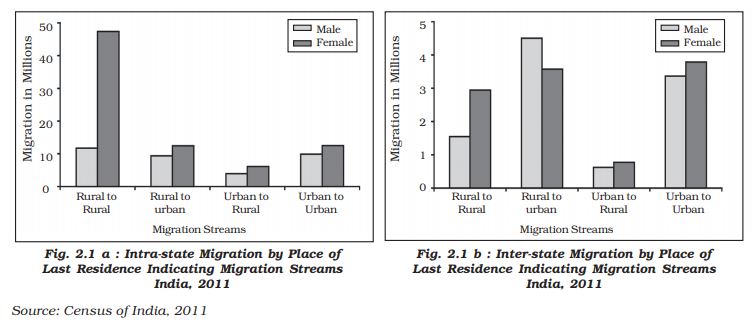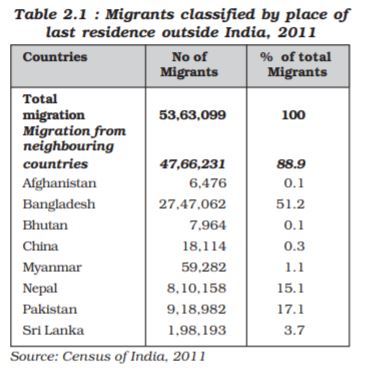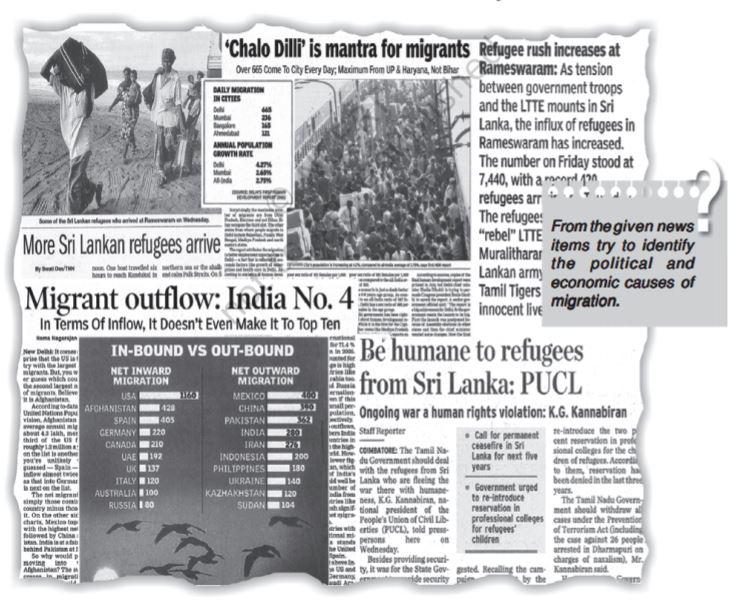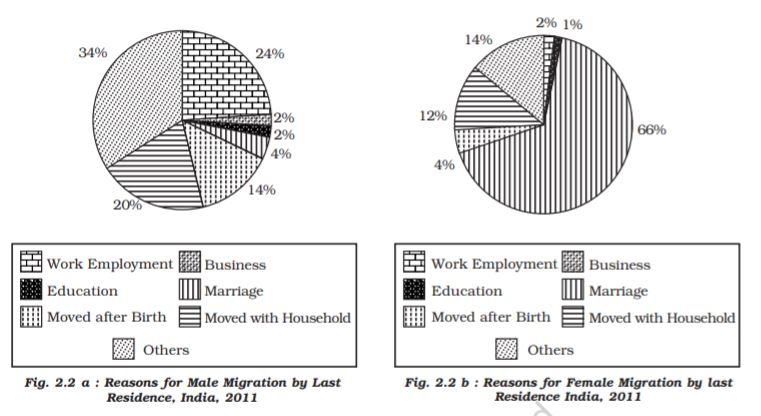Table of Contents

Unit I
Chapter 2
MIGRATION
Types, Causes and Consequences

Ram Babu, working as an engineer in Bhilai Steel Plant, Chhattisgarh, was born in a small village of district Bhojpur, Bihar. At an early age of twelve he moved to a nearby town Ara to complete his intermediate level studies. He went to Sindri, Jharkhand, for his engineering degree and he got a job at Bhilai, where he is living for the last 31 years. His parents were illiterate and the only source of their livelihood was meagre income from agriculture. They spent their whole life in that village.
Ram Babu has three children who got their education up to the intermediate level at Bhilai and then moved to different places for higher education. First one studied at Allahabad and Mumbai and is presently working in Delhi as a scientist. The second child got her higher education from different universities in India and is now working in USA. The third one after finishing her education settled at Surat after marriage.
This is not a story of only Ram Babu and his children but such movements are increasingly becoming universal trend. People have been moving from one village to another, from villages to towns, from smaller towns to bigger towns and from one country to another.
In your Book Fundamentals of Human Geography you have already learnt about the concept and definition of migration. Migration has been an integral part and a very important factor in redistributing population over time and space. India has witnessed the waves of migrants coming to the country from Central and West Asia and also from Southeast Asia. In fact, the history of India is a history of waves of migrants coming and settling one after another in different parts of the country. In the words of a renowned poet Firaque Gorakhpuri;
SAR ZAMIN-E-HIND PAR AQWAM-E-ALAM KE FIRAQUE
KAFILE BASTE GAYE, HINDOSTAN BANTA GAYA
(The carvans of people from all parts of the world kept on coming and settling in India and led to the formation of India.)
Similarly, large numbers of people from India too have been migrating to places in search of better opportunities specially to the countries of the Middle-East, Western Europe, America, Australia and East and South East Asia.
Indian Diaspora
During colonial period (British period) millions of the indentured labourers were sent to Mauritius, Caribbean islands (Trinidad, Tobago and Guyana), Fiji and South Africa by British from Uttar Pradesh and Bihar; to Reunion Island, Guadeloupe, Martinique and Surinam by French and Dutch and by Portuguese from Goa, Daman and Diu to Angola, Mozambique to work as plantation workers. All such migrations were covered under the time-bound contract known as Girmit Act (Indian Emigration Act). However, the living conditions of these indentured labourers were not better than the slaves.
The second wave of migrants ventured out into the neighbouring countries in recent times as professionals, artisans, traders and factory workers, in search of economic opportunities to Thailand, Malaysia, Singapore, Indonesia, Brunei and African countries, etc. and the trend still continues. There was a steady outflow of India’s semi-skilled and skilled labour in the wake of the oil boom in West Asia in the 1970s. There was also some outflow of entrepreneurs, storeowners, professionals, businessmen to Western Countries.
Third wave, of migrant was comprised professionals like doctors, engineers (1960s onwards), software engineers, management consultants, financial experts, media persons (1980s onwards), and others migrated to countries such as USA, Canada, UK, Australia, New Zealand and Germany, etc. These professional enjoy the distinction of being one of highly educated, the highest earning and prospering groups. After liberalisation, in the 90s education and knowledge–based Indian emigration has made Indian Diaspora one of the most powerful diasporas in the world.
Migration
You are familiar with Census in India. It contains information about migration in the country. Actually migration was recorded beginning from the first Census of India conducted in 1881. This data were recorded on the basis of place of birth. However, the first major modification was introduced in 1961 Census by bringing in two additional components viz; place of birth i.e. village or town and duration of residence (if born elsewhere). Further in 1971, additional information on place of last residence and duration of stay at the place of enumeration were incorporated. Information on reasons for migration were incorporated in 1981 Census and modified in consecutive Censuses.
In the Census the following questions are asked on migration :
• Is the person born in this village or town? If no, then further information is taken on rural/urban status of the place of birth, name of district and state and if outside India then name of the country of birth.
• Has the person come to this village or town from elsewhere? If yes, then further questions are asked about the status (rural/urban) of previous place of residence, name of district and state and if outside India then name of the country.
In addition, reasons for migration from the place of last residence and duration of residence in place of enumeration are also asked.
In the Census of India migration is enumerated on two bases : (i) place of birth, if the place of birth is different from the place of enumeration (known as life-time migrant); (ii) place of residence, if the place of last residence is different from the place of enumeration (known as migrant by place of last residence). As per 2011 census, out of 1,210 million people in the country, 455.8 million (about 37%) were reported as migrants of place of last residence.

Conduct a survey of five households in your neighbourhood to find out their migration status. If migrants, classify these on the basis of the two criteria mentioned in the text.
Streams of Migration
A few facts pertaining to the internal migration (within the country) and international migration (out of the country and into the country from other countries) are presented here. Under the internal migration, four streams are identified: (a) rural to rural (R-R); (b) rural to urban (R-U); (c) urban to urban (U-U); and (d) urban to rural (U-R). In India, during 2011, out of 455.0 million migrants, enumerated on the basis of the last residence, 141.9 million had changed their place of residence in the last ten years. Out of these, 118.7 million were intra-state migrants. The stream was dominated by female migrants. Most of these were migrants related to marriage.
The distribution of male and female migrants in different streams of intra-state and inter-state migration is presented in Fig. 2.1 a and 2.1 b. It is clearly evident that females predominate the streams of short distance rural to rural migration in both types of migration. Contrary to this, men predominate the rural to urban stream of inter-state migration due to economic reasons.
Apart from these streams of internal migration, India also experiences immigration from and emigration to the neighbouring countries. Table 2.1 presents the details of migrants from neighbouring countries. Indian Census 2011 has recorded that more than 5 million person have migrated to India from other countries. Out of these, about 88.9 per cent came from the neighbouring countries: Bangladesh followed by Nepal and Pakistan.

Represent the data given in Table 2.1 by pie diagrams assuming the migration from neighbouring countries 47,66,231 persons as 100 per cent).
Spatial Variation in Migration
Some states like Maharashtra, Delhi, Gujarat and Haryana attract migrants from other states such as Uttar Pradesh, Bihar, Rajasthan, etc. Maharashtra occupied first place in migrants, followed by Delhi, Gujarat and Haryana. On the other hand, Uttar Pradesh was the state, which had the largest number of net out-migrants from the state.
Causes of Migration
People, generally are emotionally attached to their place of birth. But millions of people leave their places of birth and residence. There could be variety of reasons. These reasons can be put into two broad categories : (i) push factor, these cause people to leave their place of residence or origin; and (ii) pull factors, which attract the people from different places.
In India people migrate from rural to urban areas mainly due to poverty, high population pressure on the land, lack of basic infrastructural facilities like health care, education, etc. Apart from these factors, natural disasters such as, flood, drought, cyclonic storms, earthquake, tsunami, wars and local conflicts also give extra push to migrate. On the other hand, there are pull factors which attract people from rural areas to cities. The most important pull factor for majority of the rural migrants to urban areas is the better opportunities, availability of regular work and relatively higher wages. Better opportunities for education, better health facilities and sources of entertainment, etc., are also quite important pull factors.
Examine the reasons for migration for males and females separately in Fig. 2.2. On the basis of the figures, it can be seen that reason for migration of males and females are different. For example, work and employment have remained the main cause for male migration (26 per cent) while it is only 2.3 per cent for the females. Contrary to this, about 67 per cent of females move out from their parental houses following their marriage. This is the most important cause in the rural areas of India except in Meghalaya where reverse is the case.
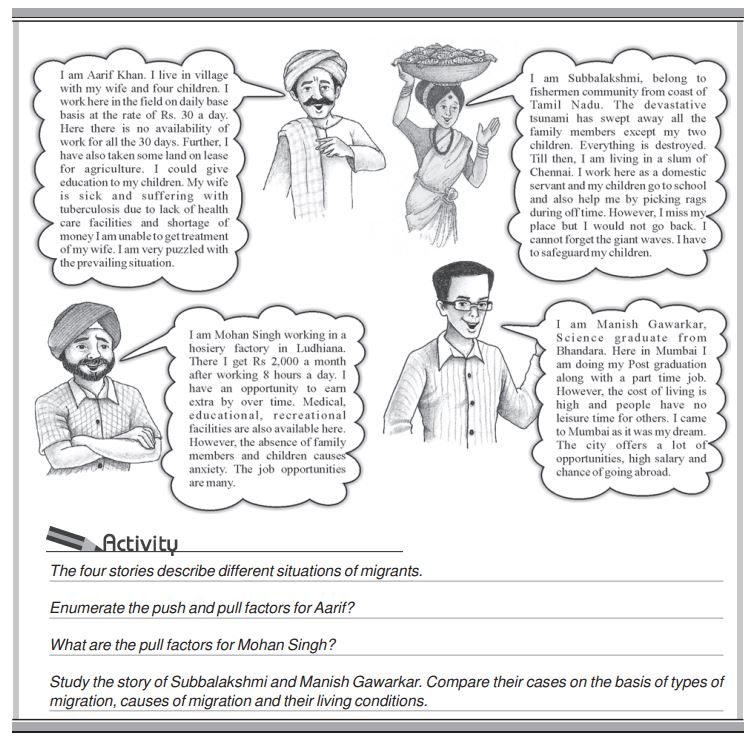
Why is the female marriage migration law in Meghalaya different?
In comparison to these marriage migration of the male, is only 4 per cent in the country.
Consequences of Migration
Migration is a response to the uneven distribution of opportunities over space. People tend to move from place of low opportunity and low safety to the place of higher opportunity and better safety. This, in turn, creates both benefits and problems for the areas, people migrate from and migrate to. Consequences can be observed in economic, social, cultural, political and demographic terms.
Economic Consequences
A major benefit for the source region is the remittance sent by migrants. Remittances from the international migrants are one of the major sources of foreign exchange. In 2002, India received US$ 11 billion as remittances from international migrants. Punjab, Kerala and Tamil Nadu receive very significant amount from their international migrants. The amount of remittances sent by the internal migrants is very meagre as compared to international migrants, but it plays an important role in the growth of economy of the source area. Remittances are mainly used for food, repayment of debts, treatment, marriages, children’s education, agricultural inputs, construction of houses, etc. For thousands of the poor villages of Bihar, Uttar Pradesh, Odisha, Andhra Pradesh, Himachal Pradesh, etc. remittance works as life blood for their economy. Migration from rural areas of Eastern Uttar Pradesh, Bihar, Madhya Pradesh and Odisha to the rural areas of Punjab, Haryana, Western Uttar Pradesh accounted for the success of their green revolution strategy for agricultural development. Besides this, unregulated migration to the metropolitan cities of India has caused overcrowding. Development of slums in industrially developed states such as Maharashtra, Gujarat, Karnataka, Tamil Nadu and Delhi is a negative consequence of unregulated migration within the country.
Can you name some other positive and negative consequences of migration?
Demographic Consequences
Migration leads to the redistribution of the population within a country. Rural urban migration is one of the important factors contributing to the population growth of cities. Age and skill selective out migration from the rural area have adverse effect on the rural demographic structure. However, high out migration from Uttarakhand, Rajasthan, Madhya Pradesh and Eastern Maharashtra have brought serious imbalances in age and sex composition in these states. Similar imbalances are also brought in the recipients states. What is the cause of imbalance in sex ratio in the place of origin and destination of the migrants?
Social Consequences
Migrants act as agents of social change. The new ideas related to new technologies, family planning, girl’s education, etc. get diffused from urban to rural areas through them.
Migration leads to intermixing of people from diverse cultures. It has positive contribution such as evolution of composite culture and breaking through the narrow considerations and widens up the mental horizon of the people at large. But it also has serious negative consequences such as anonimity, which creates social vacuum and sense of dejection among individuals. Continued feeling of dejection may motivate people to fall in the trap of anti-social activities like crime and drug abuse.
Environmental Consequences
Overcrowding of people due to rural-urban migration has put pressure on the existing social and physical infrastructure in the urban areas. This ultimately leads to unplanned growth of urban settlement and formation of slums shanty colonies.
Apart from this, due to over-exploitation of natural resources, cities are facing the acute problem of depletion of ground water, air pollution, disposal of sewage and management of solid wastes.
Others
Migration (even excluding the marriage migration) affects the status of women directly or indirectly. In the rural areas, male selective out migration leaving their wives behind puts extra physical as well mental pressure on the women. Migration of ‘women’ either for education or employment enhances their autonomy and role in the economy.
If remittances are the major benefits of migration from the point of view of the source region, the loss of human resources particularly highly skilled people is the most serious cost. The market for advanced skills has become truly a global market and the most dynamic industrial economies are admitting and recruiting significant proportions of the highly trained professionals from poor regions. Consequently, the existing underdevelopment in the source region gets reinforced.
EXERCISES
1. Choose the right answers of the following from the given options.
(i) Which one of the following is the main reason for male migration in India?
(a) Education (c) Work and employment
(b) Business (d) Marriage
(ii) Which one of the following states receives maximum number of immigrants?
(a) Uttar Pradesh (c) Maharashtra
(b) Delhi (d) Bihar
(iii) Which one of the following streams is the main reason for female migration in India?
(a) Education (c) Work & Employment
(b) Business (d) Marriage
2. Answer the following questions in about 30 words.
(i) Differentiate between life-time migrant and migrant by last residence.
(ii) Identify the main reason for male/female selective migration.
(iii) What is the impact of rural-urban migration on the age and sex structure of the place of origin and destination?
3. Answer the following questions in about 150 words.
(i) Discuss the consequences of international migration in India.
(ii) What are the socio demographic consequences of migration?

